Principles and the specifics of strengthening
First, the term strength training needs to be explained. It is training which increases muscle strength and muscle endurance and improves body composition. The decisive factor that determines the effectiveness of strength is the size of the load and the associated number of repetitions of the exercise: the optimal load leading to the desired physiological changes is the load where momentary muscle fatigue is reached within 60-90 seconds after 8-16 repetitions of the exercise. The muscles will adapt to the load after 6 to 10 weeks and for further development it would be necessary to increase the load and modify exercises to a heavier version.
It cannot be forgotten that bodystyling lessons are mainly aerobic training, in these lessons, the heart rate should be at least 12-20 minutes in the aerobic zone, i.e. between 60-80% of the maximum heart rate (Krištofič, 2007).
Fundamentals of strength training:
- we are using the system of sets and repetitions (set – number of repetitions done without a break, repetition – exercise is done one time),
- the number of sets and repetitions vary depending on the type of training,
- the first set (warm up) - higher number of repetitions, lower load,
- work sets - power development - fewer repetitions (3-5) in 3-4 sets, rest 1,5 - 2 min, muscle volume - higher number of repetitions (8-12) in 2-3 sets, rest 45s - 1min,
- for smaller muscle groups use lower number of repetitions,
- it is generally recommended 3-8 sets of 8-12 repetitions with a weight of 70% one-rep max.
(Jarkovská,2009)
Safety principles of strength training:
- the amount of load or resistance - In strength training, a load equivalent to 70-80% of the maximum (RM) manageable load is recommended as the most effective, that is, a load with which the trainee is able to perform a maximum of 12-15 reps. In bodystyling lessons, the amount of the load is given by the weight of your body and by the resistance of the fitness equipment. We can’t increase the load regularly regarding adaptation, therefore we cannot achieve these overload loads leading to the development of muscle strength. The intensity can influence only by increasing the number of repetitions, which can lead to improved muscle endurance.
- the speed of movement - The movement in both phases should be slow and controlled, so that the muscle can develop its power smoothly, swinging and pendulum movements are inappropriate for strengthening and increase the risk of injury. In bodystyling lessons, the speed of the exercise is not individual, but it is determined by the instructor, or by the speed of the music he/she chooses. It is difficult to accurately state the speed of the music suitable for strengthening, mostly 135-140 BPM is used for complex exercises in a standing position; for floor work (strengthening on the floor) and strengthening with tools is most often from 120 to 130 BPM used. Of course, the instructor can work with faster music but needs to extend concentric and eccentric phases (e.g. for 8 counts).
- range of motion - Motion should be carried out in full range, a final position in which the muscle at maximum contraction should always be achieved. Incomplete movement involves less muscle fibers, and the developing force decreases.
- posture and technique - Any exercise can lead to injury or to inappropriate overload if it is not done in the correct position with optimal posture and with the correct technique. The instructor emphasizes the correct posture, must possess perfect technique of the exercises and, by appropriate verbal expression and cueing, to lead in these directions for all trainees.
- the correct exercise technique – movements are performed smoothly and controlled in concentric and eccentric phase, we fully extend the knees and elbows but not to the position of hyperextension (locking) of the joint, wrists are in neutral position. The most common mistake is that instead of weak phasic muscle performing the work, postural muscles are overloaded and shortened thereby further exacerbating muscle disbalance, instead of being removed by appropriate exercises and proper implementation.
- breathing - regular and deep breathing oxygenates the blood flowing to the muscles. The basic rule is to combine exhalation with maximum muscle performance, i.e., in concentric contraction phase. A common mistake is holding your breath, which can be a problem especially during a static contraction, when the return of venous blood to the heart is reduced, blood pressure increases, and faint occurs (Valsal effect).
(Hálková, 2001)
Strengthening exercises
Strengthening exercises are the counterpart of stretching exercises. We strengthen the muscles that need to increase the tone, to develop strength. Strengthening exercises have their own specifics based on healthy exercisers, athletes and exercisers who are medically fragile. For athletes, it's about strengthening the muscle that an athlete needs to be strong to achieve optimal performance. In healthy exercise, with average body fitness, it is about strengthening the muscles of the whole body. In health physical education, the goal is to strengthen primarily muscles that are flaccid, relaxed, or proportionally strengthen muscles that tend to weaken. Sometimes it is necessary to increase the muscular tension of the shortened muscles, because even they may be weak.
Strengthening is done:
- dynamically:
- movements without load,
- movements against resistance,
- movement using tools,
- isometrically – the muscle does not change its length.
For strengthening exercises, it is important to practice slowly, movements must be smooth with controlled motion, to be precise. We start with a small number of repetitions and gradually increase them. After the strengthening exercise it is necessary to release. When you release, don’t hold your breath. Therefore, dynamic strengthening is practiced without load, and then against the resistance until the end methodical process when we can use equipment and tools (Adamírová, 2003).
Types of strengthening
Strengthening with your own body weight
Strengthening in Bodystyling is carried out either with only one’s own body weight or the load may be increased with the use of fitness equipment.
When exercising with one's own body, the principle of regularity is very important. This exercise is not so strenuous, so we include it with a rather less intensity, almost every day. The big difference in exercise intensity is, of course, given by the weight of each individual. If there is a weight problem, we prefer exercises that take place on the floor in order to not overload the already overloaded joints (Strakoš & Valouch, 2005).
Strengthening with tools
1. Dumbbells
Dumbbells for women are designed for aerobic or dynamic exercise.
Strengthening results with weights, with the appropriate type of training, will reduced fat deposits and tone muscles, but will not increase its mass. Women use dumbbells especially for definition of arms and torso during an aerobics and fitness sessions. For these purposes, special dumbbells for ladies and dumbbells for aerobics are manufactured.
Types of dumbbells for women
Dumbbells are made for women as well as standard dumbbells in two basic designs:
- so-called monoblocks without the possibility of loading
- and loading dumbbells.
Among dumbbells we can also include:
- clip-on weights with low weights.
For women, it is recommended to start with dumbbells weighing from 0,5 kg - 2 kg and practice with more repetitions. The load can be gradually increased up to 5 kg - 6 kg.
a) Monoblocks, dumbbells for aerobics
- Dumbbells called monoblocks are fixed without the possibility of weight change. A predetermined weight, which we do not need to change too much, is typical for aerobics, Zumba, etc. These dumbbells are lightweight and feature special anti-slip fasteners.
- Monoblocks are available in several designs. We can find different materials from plastic to steel alloy - usually chrome.
b) Loading dumbbells
- Loading dumbbells are more typical for men, because they allow the increase of the load above 10 kg.
- For women who want to get rid of fat and develop their muscles with aerobic exercise, a maximum weight of 6 kg is recommended. The dumbbell rod itself weighs 1 kg, you can start just with that, and after a while add smaller plates, each weighting1,5 kg, but it's a too big of a jump in weight.
- Currently in aerobic exercise lessons a barbell so called "pump fx" is used. It's safe, it has rubberized discs that are color-coded by weight. Lessons with this tool have the effect of intense fat burning, muscle growth and endurance. Optimal load and intensity are optimized for trainees.
Strengthening with dumbbells is one of the best exercises. Dumbbells are used to strengthen the upper body and can be a great addition to strengthening the lower body. Dumbbells allow a wide range of motion and require more effort to stabilize the muscles, so strength training is very effective. They provide plenty of options for different muscles in the body, including:
- strokes for biceps training,
- training to strengthen the triceps and deltoid muscles
- bench press is perfect for strengthening your chest - pectoral shapes, anterior deltoid and triceps muscle.
- reverse fly strengthens the upper back and shoulders,
- lunges: great exercises for the legs and buttocks,
- Sit-ups strengthen the belly - transverse abdominal and oblique abdominal muscles.
Dumbbells can be used for independent strength training or included in aerobic exercise to increase exercise intensity.

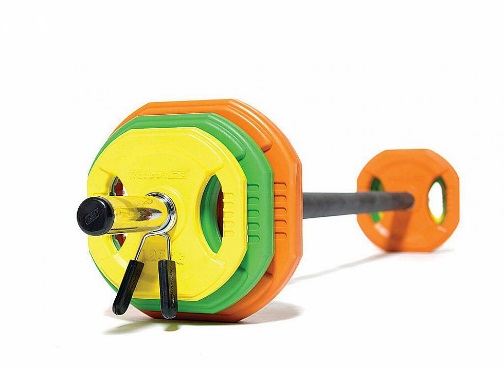
2. Resistance bands
Resistance bands have a versatile use when practicing at fitness centers or at home. As a versatile, low-cost, and very easy-to-use aid, it will ensure the strengthening of most muscles or better rehabilitation. Depending on your training focus and intensity, you can always choose from several levels of stiffness /difficulty.
a) Resistance mini-bands
- rubber bands for conditional exercise and also for the use in aerobics centers,
- material: standard consistency rubber or latex rubber, maximum elasticity and much smoother stroke across the entire range of motion,
- 5 levels.
A very popular tool for versatile home exercises also widely used for compensatory exercises and it is used alone or in the so-called eights.
- latex belt length 120 - 200 cm,
- rehabilitation and strengthening exercises with smaller and larger range of motion,
- different intensity levels.
Efficient and variably useful tool for home use, as well as group exercises according to resistance levels suitable for both beginners and advanced. It has small dimensions and low weight.
- During exercise, the belt should be constantly under the tension (the constant muscle tone is safe for the joints).
- We should practice with smooth movements, the force is developed evenly, avoiding rapid shrinkage of the belt when returning from the position of maximum resistance.
- Wrists are in neutral position = in natural extension of the forearms.
- If the belt is placed under the foot, make sure it is secure enough (it also applies to securing the band to other parts of the body or objects).
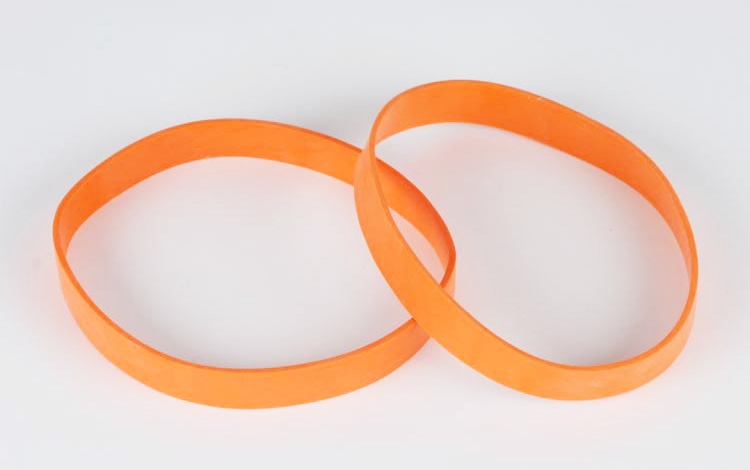

3. Balls
Various types of balls are also widely used for the variability of exercise lessons. Some are small but heavy, some large and light. These balls are called fitball and overball. Balls are used as a load or for balance (Strakoš & Valouch, 2005).
a) Overball
Exercising with a small soft ball – overball provides interesting opportunities for training all muscles both in stretching and toning exercises. Overball is a soft ball, with a diameter of 30 cm, which can be inflated to the desired size with the attached tube. You can practice with a full-blown ball but also use a half inflated ball to practice. The ball is maintenance-free and has a carrying capacity of 120 kg.
The lightweight, small, flexible, soft inflatable overball was developed by Ledraphlastic primarily for breathing exercises. It allows the lungs to increase in volume, especially in children. Another feature was the improvement of hand motor skills, both after injuries and in healthy people, for example, in the shortening of tendons. Rehabilitation and physiotherapists began to use this ball for corrective exercises. As a balance tool, such as overball, engages deep stabilizing muscular system - pelvic floor, neck muscles, deep flexor muscles of the neck and deep back muscles which together with the abdominal muscles fix the spine in the correct position. This tool, in terms of the effectiveness of the exercises and almost perfect stretching of the muscles which have a tendency to shorten, becomes unusually popular. This is mainly due to the variety of uses ranging from physiotherapy facilities to households or transport. For light aerobics it is ideal to inflate the ball half to two thirds. The more you inflate it, the more intense your exercise will be to highlight the balance positions, in which the deep stabilizing muscle system is activated, and exercises are more difficult.
b) Fitball
Gymnastic ball with the names fitball, powerball, pushball, gymnastic ball, RehaBall, physioball, pezziball, bodyball refers to a large inflatable, elastic plastic ball. It is available in different colors and is produced by different companies. It varies depending on the type of plastic, its roughness, its resistance to the load, and the flexibility or the surface finish.
Exercise on a fitball includes balancing elements that put static load on the spine, thereby reinforcing the trunk muscles, and contributing to the proper posture. Because of the variety of exercise choices, the ball is another motivating element in bodystyling lessons.
Advantages and benefits of the fitball:
- Fitball strengthens the body while increasing proprioception.
- It helps to focus attention on how we perceive and interpret the stimuli and feelings of the outside world.
- It is used to rehabilitate motor skills.
- Spinal extensors muscles keep the spine erect during exercise.
- Jumping on a fitball is a dynamic, yet safe, cardiovascular exercise and helps to develop balance skills.
- It is also used as a tool to relieve stress and for stretching.
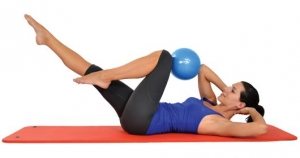

4. Bosu
Balance tool BOSU® Balance Trainer is specifically designed to help achieve a balance between muscle systems, postural and phasic chains, faster, safer and more comprehensively than any other training device of this kind. BOSU® is short for ‘both sides up , that means it can be used with the flat side either up or down for different types of balance exercises. It's something like the split ball. The solid surface is 63,5 cm in diameter, the dome should be inflated to a height of about 22 cm.
This tool can be used for bodystyling lessons. It is mostly cardiovascular training, supplemented with strengthening. The lesson consists of simple aerobic blocks performed with stepping up on the BOSU and supplemented by toning exercises.
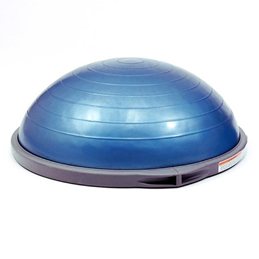
5. Step
Step has recommended dimensions: length 70 - 120 cm, width 35 cm, height 10 - 25 cm. It is used during step aerobics lessons. It is used for vertical training, with height difference by going up and down on the step. This tool can also be used in bodystyling lessons for a more intense workout.
Step Exercise Technique and Safety Principles:
- Correct upright posture without forwards and backwards.
- Height of the step must comply with proficiency, but also the body height of the trainee.
- Always put the entire foot on the step when step up.
- Descent is at the maximum distance to the size of the foot.
- One does not step off the step forward, does not jump from it, does not cross legs while on the platform.
- Until the step technique is mastered, then the arm work is added

Types of Strengthening classes
Bodystyling
It's exercise with music aimed at strengthening the major muscle groups with a mid-tempo using your own body weight and a variety of equipment - dumbbells, fitness tube, bars and overballs. Lessons consist of aerobic and strength blocks.
Tabata
Tabata is cardiovascular training that demonstrably improves performance and fitness in a very short time - 14 minutes. Exercise consists of six to seven 20-second exercises performed at 100%, alternated with rest 10 seconds. The key to efficiency in Tabata seems to be short rest periods between exercise.
Circuit training
The principle of the method is to stress muscle groups with rapid alternation at sites which are assembled into a ring according to physiological requirements. There are no breaks between the stations, the transitions are dynamic and smooth. The total time is dependent on the number of stations and the number of circuits. The choice of exercises depends on the current fitness level of the trainees, physical abilities, age and other aspects. Stations use various tools for exercise.
Power step
This is an intense strength endurance training using steps and weights to strengthen the muscles of the whole body. It is a special form of step aerobics, aimed primarily at strengthening muscles of individual muscle groups. Step aerobics is a vertical training, it is used to overcome the height difference by stepping up and down. By stepping on the step and stepping back on the pad, the height difference is overcome, resulting in a complex load on the lower limb muscles.
Deep work
Deep work is a new exercise program based on Eastern philosophy that activates the deep muscles. The basic building block is the yin & yang doctrine and teachings of the five elements (earth, wood, fire, metal and water) and their different energy. Both teachings are also the starting point for traditional Chinese medicine. DeepWORK™ is a dynamic training. Based on pre-established principles energy phases during which it alternates strength and conditioning load, tension and release. The exercise maximally engages and stretches the muscles, shapes the body, and at the same time it is an excellent cardiovascular training. An important role of exercise is the recovery of physical and mental energy. It is an athletic, simple and highly intensive exercise program.
TRX
TRX exercise is performed using adjustable straps, called suspension system. The exercise uses only body weight. During each exercise, stabilization muscles are maximally activated, and all functional training rules are maintained. TRX exercise generally improves physical fitness, strengthens the CORE - the center of the body, and shapes the figure. Suspended exercise develops physical strength through functional movements and dynamic positions. In sports and everyday exercise, movement is still practiced on many levels. Muscle mass increases evenly, which reduces the risk of injury and increases performance.
TRX: Total-Body Resistance Exercise
The TRX consists of two fixed length adjustable straps with grips used for the hands or feet. The exercise itself takes place in such a way that one part of the body is always on a support (usually on the ground) and the other is suspended on a TRX.
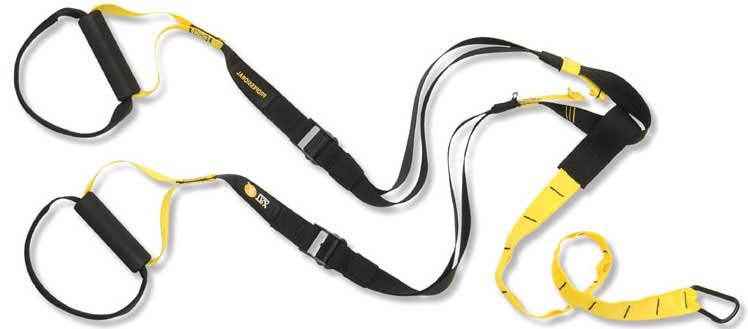
We brought some examples for strengthening classes. For use in bodystyling lessons, it is good to combine individual types
For example: Bodystyling ½ h + Tabata ½ h, Bosu ½ h + Circuit training ½ h.
The combination of these lessons is a variation that is very popular with clients due to the variability of the lessons.